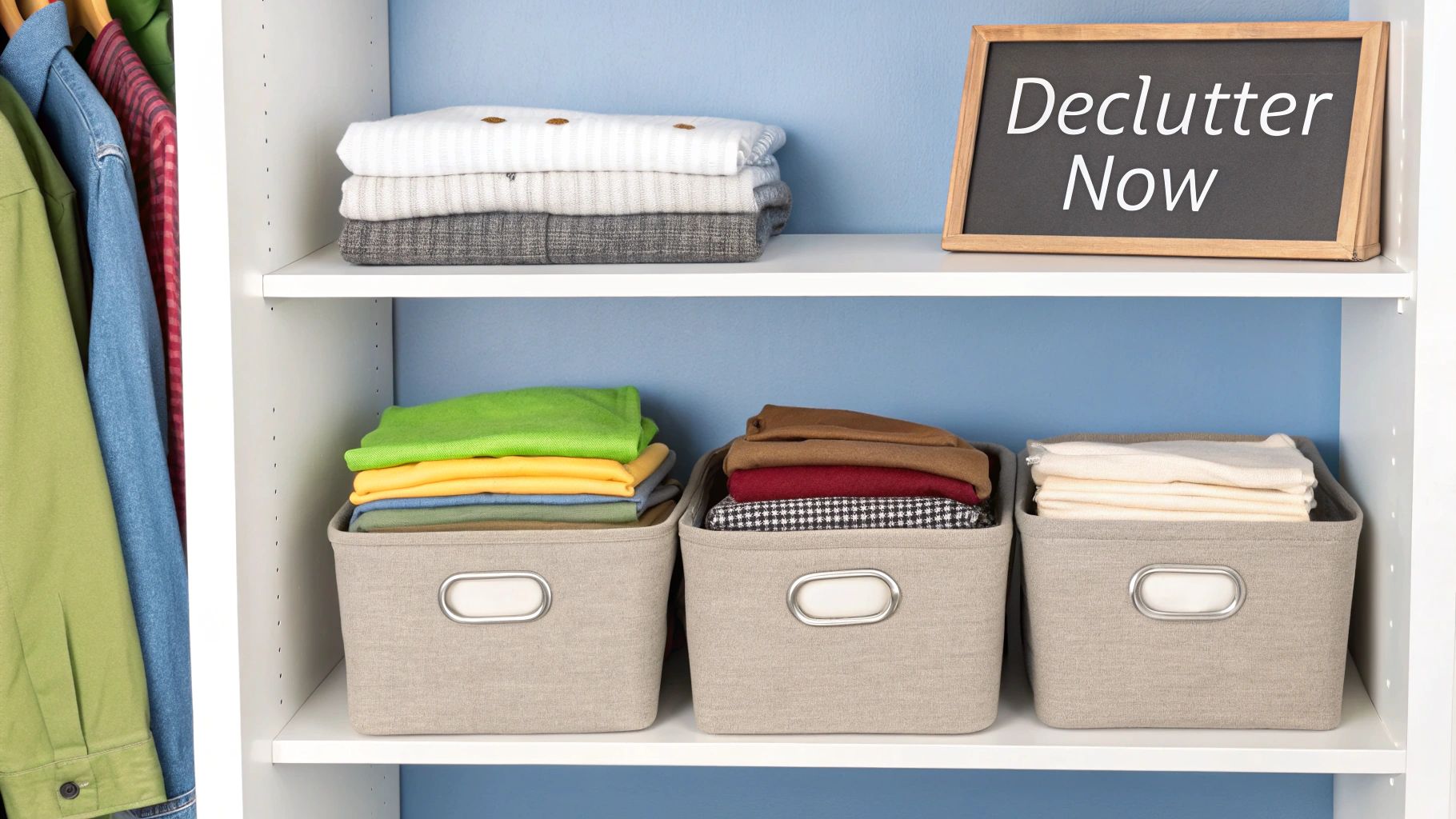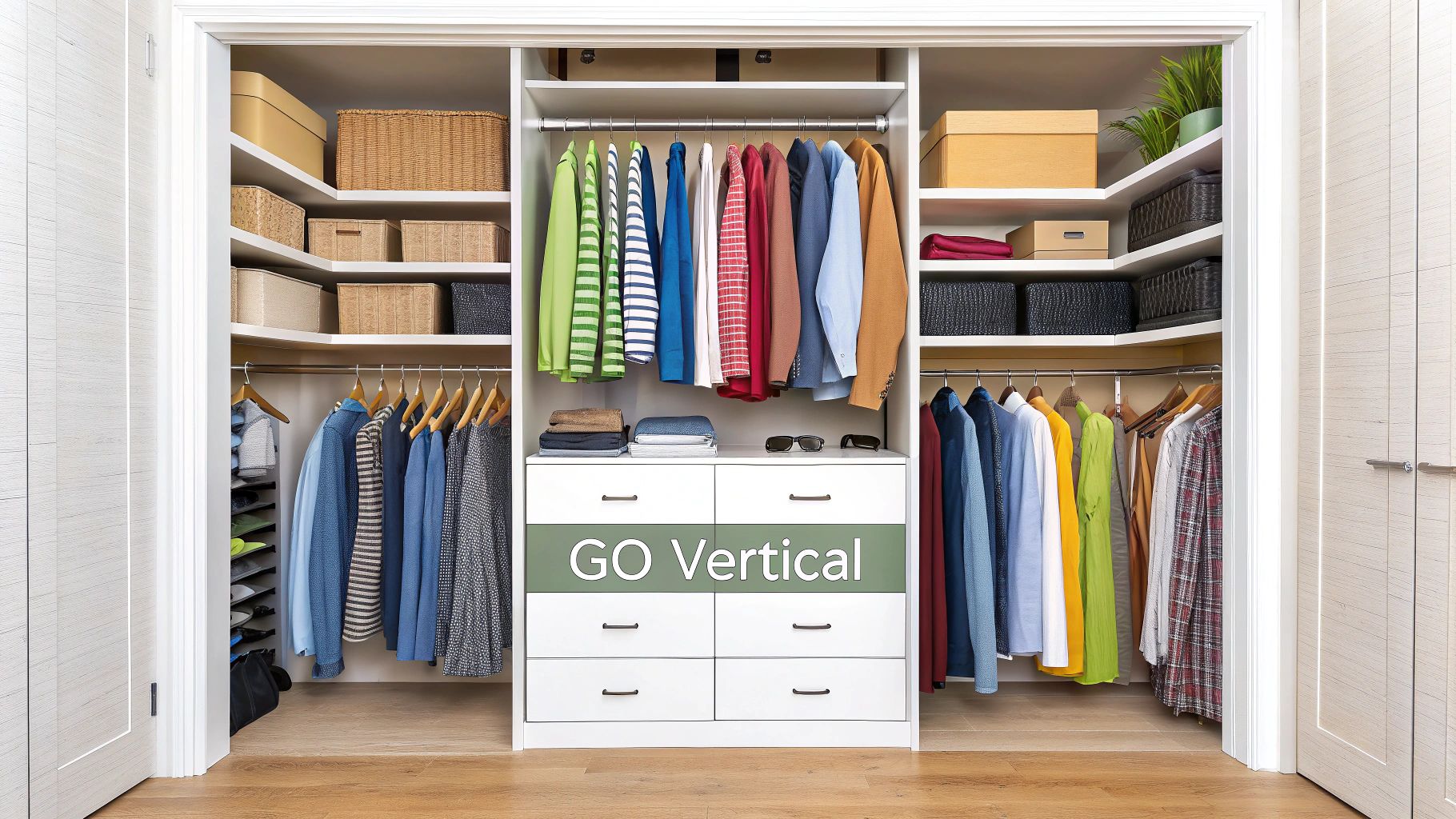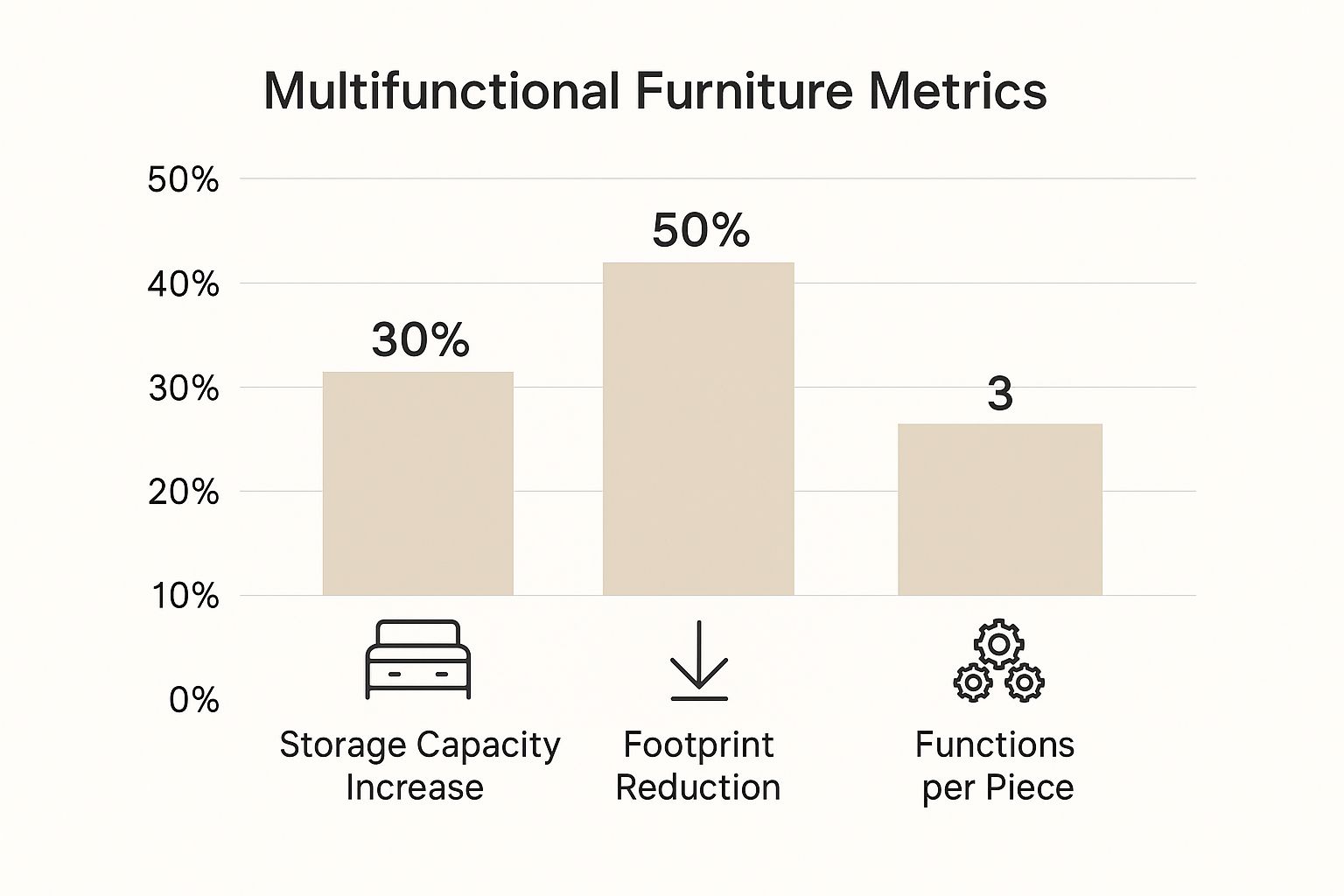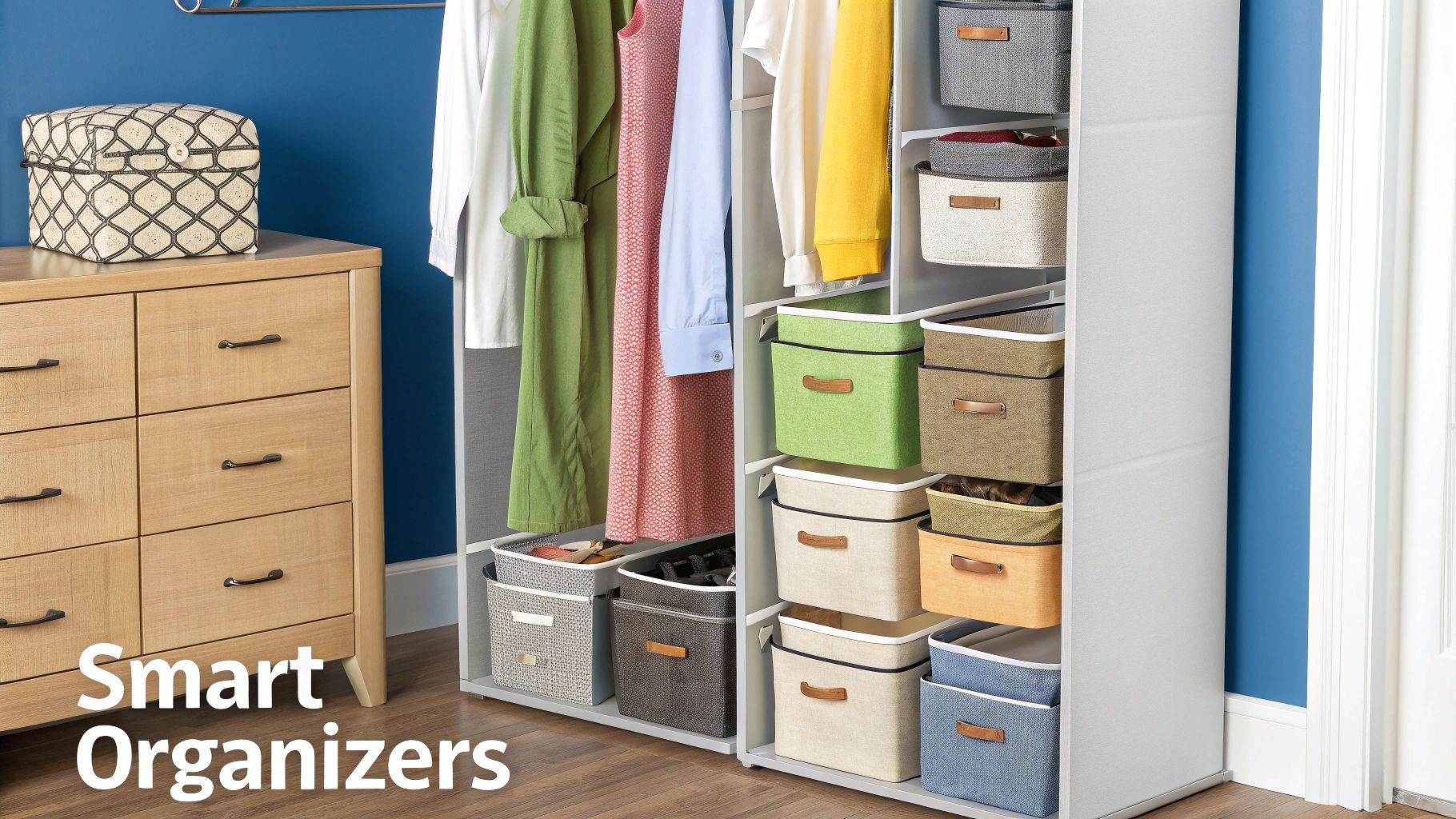How to Maximize Small Closet Space: Top Organization Tips

Let's be honest, staring into a small, jam-packed closet can be a frustrating way to start the day. The good news is, the size of your closet isn't the real issue. The key is how you organize it. Mastering a small closet boils down to three things: clearing out what you don't need, making the most of every inch of vertical space, and picking the right organizational tools for the job.
This isn't about just tidying up; it's about creating an organization system that actually works for you long-term.
Conquering The Small Closet Organization Challenge

That feeling of a closet bursting at the seams is something most of us know all too well. But instead of seeing a small closet as a limitation, think of it as an organizational challenge—an opportunity to build a truly functional, stress-free wardrobe.
This guide is designed to move past those quick fixes that just lead to more clutter a week later. We're going to focus on building a sustainable closet organization system based on three core ideas:
- Decluttering with Purpose: We’ll start by creating a solid foundation for organization, keeping only the clothes you genuinely love and actually wear.
- Smart Space Planning: You'll learn how to see—and use—every bit of available space, especially the often-ignored vertical real estate.
- Choosing the Right Organizational Tools: It's all about equipping your closet with smart solutions that genuinely create more room and maintain order.
Why We All Struggle With Closet Organization
If you feel like you're fighting for space, you're definitely not alone. With more people living in cities and homes being designed for efficiency, smart storage and organization have become a necessity. The global market for reach-in closets was valued at roughly USD 2.8 billion in 2024 and is expected to grow to USD 4.7 billion by 2033.
What's driving this? A massive boom in home remodeling. People are choosing to upgrade the spaces they already have instead of moving or expanding. This trend makes one thing clear: we're all looking for better, more effective ways to organize our stuff in a limited footprint. You can learn more about the closet market trends and see just how big this movement is.
The goal isn't just to cram more stuff into a small space. It's to create an organization system that simplifies your mornings and helps you actually enjoy the clothes you own.
By taking a structured approach to organization, you can turn your closet from a source of daily chaos into a streamlined part of your routine. It all starts with a simple shift in mindset—from "I have no space" to "How can I organize this space to work for me?"
The Art of Intentional Decluttering: The First Step in Organization

Before you even think about new organizers or clever folding techniques, the real work begins with what’s already crammed onto your shelves and hangers. Let’s be honest: great organization isn't about finding better ways to hide junk. It’s about thoughtfully curating a wardrobe filled with pieces you actually wear and love.
That’s why the first and most powerful step in any closet organization project is a good, old-fashioned decluttering session. This isn’t just tidying up; it's about laying the groundwork for a closet that stays organized for good.
To avoid that classic scenario where your entire wardrobe ends up in a mountain on your bed, try the Container Method. Just grab one box or bin and tackle a single category at a time—say, sweaters. Don't move on until that bin is full of items to donate or sell. This keeps the chaos contained and your focus sharp.
Making Smart Decisions About What To Keep
Okay, now for the hard part: deciding what stays and what goes. Vague questions like, "Do I like this?" are a trap. They open the door for guilt and "what if" scenarios that lead to keeping things you never wear. To organize effectively, you need to be direct.
As you pick up each item, ask yourself a few tough-love questions:
- Would I buy this again today? This is a game-changer. It cuts right through any sentimental attachment to an item that no longer fits your current style.
- Does this fit my life right now? That power suit from an old job? The formal dress for a type of event you haven't attended in years? If it doesn't serve the life you're living, it's just taking up precious real estate.
- Have I worn this in the last year? If the answer is no, figure out why. If it needs a button sewn on, create a small pile for repairs. Otherwise, it’s probably time to let it go.
Still struggling? Here's a simple trick I swear by: the Reverse Hanger Trick. Turn all the hangers in your closet so the hook faces out. Once you wear something, hang it back up the normal way. In six months, you’ll have a brutally honest, visual record of what you actually reach for and what’s just collecting dust.
Creating a curated wardrobe isn't about deprivation. It's about giving yourself the freedom to only interact with clothes that make you feel confident and comfortable every single day.
Once you’ve sorted your "keep" pile from the "goodbye" pile, you're finally ready to build an organization system that works. This initial purge is truly the most important part of the entire process. For a deeper dive, our complete guide on how to declutter your closet has even more tips to make it painless and effective.
Organizing Vertically: Unlocking Your Closet's Hidden Space
Now that you’ve cleared out the excess, you’re looking at the real, raw space you have to work with. A lot of people call it a day right here, but this is where the real organization begins. Learning how to maximize small closet space isn't just about what you remove; it's about seeing the organizational potential in what's left—from floor to ceiling.
Look inside your closet. I'll bet there's a ton of empty air just sitting there, completely unused. That gap above your hanging clothes? The floor space underneath? That’s prime organizational real estate.
Rethink Your Closet's Layout for Better Organization
Take a hard look at your current setup. If you see a single rod with a deep, cavernous shelf above it, you’ve got a classic, under-organized closet. The good news is, it's an easy fix.
You can literally double your hanging space in about five minutes by installing a second tension rod below the existing one. It's a game-changer for organization. This creates a perfect two-tiered system for shirts, skirts, and folded trousers. Your longer items, like dresses and coats, can stay on the top rod.
And the floor? It doesn't have to be a jumble of shoes. A slim, vertical shelving unit can turn that chaos into a neat stack of folded sweaters or jeans, freeing up even more rod space for things that actually need to be hung.
Your closet isn't just a box; it's a multi-level storage area. The key is to stop thinking horizontally and start organizing vertically. By adding layers of organization, you can effectively double or even triple your usable space without any construction.
Leverage Every Available Surface
Don’t forget about the back of the door! An over-the-door organizer is one of my favorite tricks for adding a ton of storage without taking up a single inch of shelf or floor space. It’s perfect for organizing shoes, belts, scarves, and even small handbags. Getting those items neatly stored makes your whole closet feel bigger instantly.
This is all about finding clever, multi-functional organization solutions to boost your storage capacity.

As you can see, simple additions like drawer systems or fold-down features can increase storage by 30% or more—a principle that applies perfectly to the inside of a closet.
The demand for these smart organization solutions is exploding. The global closet organizer market was valued at USD 7.64 billion in 2024 and is projected to hit USD 14.57 billion by 2032. Why the huge jump? More people are living in smaller spaces and need functional, stylish organization that actually works.
Vertical Organization Techniques
To make the most of every vertical inch, you need the right tools for the job. Not every organizational solution is created equal, and what works for shoes might not work for sweaters.
Here’s a quick comparison of some of the most effective organizational techniques to help you decide what’s best for your closet.
| Technique / Tool | Best For | Space Gained | Average Cost |
|---|---|---|---|
| Double Tension Rods | Shirts, blouses, folded pants, skirts | Doubles hanging capacity for shorter items | $15 - $30 |
| Slim Shelving Units | Folded clothes (jeans, sweaters), shoe boxes | High; converts floor space into layered storage | $30 - $100 |
| Over-the-Door Organizer | Shoes, accessories, scarves, belts | Significant; adds storage without using interior space | $20 - $50 |
| Hanging Shelf Organizers | Sweaters, t-shirts, handbags | Medium; creates "cubbies" on the hanging rod | $15 - $40 |
| Under-Shelf Baskets | Small accessories, socks, folded items | Low to Medium; uses the dead space under shelves | $10 - $25 |
Choosing a combination of these methods can completely transform a cramped closet into an organized and surprisingly spacious area.
As you start adding more hanging space, you'll want to make sure your hangers are just as efficient. For some great tips, check out our guide on how to store hangers to keep everything tidy.
Choosing The Right Organizational Tools

Alright, you’ve done the hard part—you’ve decluttered, sorted, and planned your closet’s layout. Now comes the fun part: picking out the gear that will bring your organization plan to life. Think of these tools as the support system for your newly reclaimed space. The right equipment can completely transform how your closet works, carving out usable space from thin air.
This isn’t about just buying a bunch of bins. It’s about being strategic and choosing smart, functional organizers that will genuinely maximize every last inch of your small closet.
The Undeniable Power of Slim Hangers
If I could recommend only one organization tool for a small closet, it would be to ditch your old hangers. Seriously. Those bulky plastic and thick wooden ones are space hogs, gobbling up precious real estate on your closet rod. Switching to a uniform set of slim, non-slip hangers is easily the most impactful organizational change you can make.
Think about it this way: a standard set of 25 chunky wooden hangers can take up the same room as 50 slim velvet hangers. Just by making that one simple swap, you can instantly double your hanging space. That’s up to 50% more room for your clothes to breathe, making it so much easier to flick through and find what you’re looking for. Plus, their velvety grip means no more slinky tops or wide-neck shirts slipping off and ending up in a sad pile on the floor.
Cascading or "waterfall" hangers are another organizational game-changer. These let you hang multiple pieces—think shirts, skirts, or even pre-planned outfits—in a single vertical stack. They’re fantastic for grouping similar items or getting your outfits ready for the week, turning a crammed rod into a tidy, layered system.
Your hangers are the foundation of your closet organization. Choosing the right ones is like upgrading from a two-lane road to a four-lane highway—everything just flows better, with a lot more room to maneuver.
Beyond Hangers: Organizers For Every Nook
While great hangers solve your rod problem, you still have to tame the shelves and floor space. Without some structure, these zones quickly turn into chaotic catch-alls for everything else. Proper organization requires the right tools.
- Clear Stackable Bins: These are perfect for that high, hard-to-reach top shelf. Use them for off-season items like bulky sweaters, scarves, or swimwear. Because they’re clear, you know exactly what’s inside at a glance, and their stackable design ensures you’re using every bit of that vertical height.
- Drawer Dividers: A messy drawer can sabotage an otherwise organized closet. Adjustable dividers are the secret to taming socks, underwear, and accessories. They create neat little compartments for each category, putting an end to that frantic morning search for a matching pair of socks.
- Fabric Bins: For any open shelving, fabric or woven bins look great and are incredibly useful for stashing T-shirts, workout clothes, or small purses. They add a bit of style while preventing those carefully folded stacks from toppling over.
The demand for smarter wardrobe organization is huge. In fact, the global market was valued at USD 66.31 billion in 2024 and is expected to keep growing. This is largely driven by people in urban areas with smaller homes who need modular, space-efficient furniture to make their lives work.
By combining the right hangers with a few smart containers, you’re not just organizing—you’re creating a complete, functional system. To see how all these pieces fit into the bigger picture, check out our guide on how to design a closet. It’s a great resource for planning your perfect space from the ground up.
Maintaining Your Organized Closet for the Long Haul
So, you’ve put in the work. You’ve decluttered, installed some smart organizers, and finally have a closet you can be proud of. Fantastic! The real challenge, though, is keeping it that way.
Great organization isn’t a one-and-done project. It’s a series of small, repeatable habits that stop your closet from slowly sliding back into chaos. These routines don’t have to eat up your weekend; they’re all about small, consistent efforts that protect the peaceful, functional system you worked so hard to build.
Stick to the 'One In, One Out' Rule
One of the single most effective habits for preventing new clutter and maintaining organization is the 'one in, one out' rule. The idea is brilliantly simple: every time a new piece of clothing comes into your home, a similar item has to go.
Did you just buy a new pair of jeans? An old pair gets donated. Received a new sweater for your birthday? It's time to pick one you haven't worn in a while to pass along. This little habit makes you so much more mindful of what you buy and physically stops your wardrobe from outgrowing the small space you have.
This isn't about depriving yourself; it's about maintaining organizational balance. The 'one in, one out' rule keeps your closet as a curated collection of things you actually love and wear, stopping the clutter-creep before it even gets a foothold.
For anyone with a small closet, this kind of discipline is a game-changer because it forces you to respect the physical limits of your space. It's the best proactive defense against future clutter.
Schedule a Quick Closet Tidy-Up
Look, even the most perfectly organized closet will get a little disheveled during a busy week. We've all been there—clothes get put back in a hurry, and accessories don't quite make it back to their designated homes. The fix? A quick 10-minute 'closet reset' once or twice a month.
Seriously, just set a timer and spend those ten minutes putting everything back in its place.
- Quickly refold that messy pile of sweaters or t-shirts.
- Straighten out the shoes on their racks.
- Hang up the jacket that’s been living on that chair.
- Put your belts, scarves, and bags back on their hooks or in their bins.
This isn’t another deep clean or a full-on decluttering session. It’s just a bit of maintenance that prevents little messes from turning into a major organizational headache.
Master the Seasonal Swap
If you live somewhere with four distinct seasons, rotating your wardrobe is an essential organization strategy. Stashing your off-season clothes frees up a huge amount of precious real estate in your closet, but you need a good system to do it right.
First, always make sure everything is clean before you store it. Stains can set in over time, and you don’t want to attract any pests. Once everything is fresh, grab some vacuum-sealed bags for bulky items like puffy winter coats and chunky sweaters. These things are magic—they can shrink your items by up to 75%, making them easy to tuck away on a high shelf or slide under the bed.
Make sure to label every bag or bin so you’re not guessing what’s inside. When the seasons turn again, your swap will be quick and painless, and your closet will stay relevant, accessible, and wonderfully organized.
A Few Common Questions I Get Asked About Small Closet Organization
Even with the best game plan, it's easy to hit a snag when you're knee-deep in clothes and boxes. Getting stuck on one little detail can bring the whole project to a halt. So, let’s tackle some of the most common questions I hear from people trying to figure out how to maximize small closet space through better organization.
Okay, I’m Standing in Front of My Messy Closet. What’s the Very First Thing I Do?
When you’re staring down a closet that’s completely out of control, the absolute first step is a hard one: take everything out. I know, it sounds like a nightmare. But trust me, you can't organize clutter while it's still in the closet. You need a blank canvas.
Dump every last thing—every shirt, shoe, and forgotten scarf—onto your bed or a clear spot on the floor. This simple act is more powerful than it seems. It forces you to physically touch every single item, making you decide if it truly deserves to go back in. Plus, seeing the empty space gives you a real sense of its dimensions, so you can plan your organizational attack before anything goes back in.
Are Those Expensive Custom Closet Systems Actually Worth It?
Custom systems can be incredible, but for a small closet? They're often overkill. The big selling point of a custom build is that it uses every last inch of a uniquely shaped space. The thing is, you can get 90% of that same organizational benefit with some smart, off-the-shelf products for way less money.
By mixing and matching affordable tools—think adjustable shelving, an extra tension rod here and there, and of course, some good space-saving hangers—you can build a system that feels custom-made for your stuff.
My advice? Look into a custom system if your closet has a super weird shape or if you want a permanent, high-end upgrade. Otherwise, don't feel pressured. You can achieve a fantastic, organized space on your own.
How Should I Organize My Bulky Sweaters and Coats?
This is a big one. For anything bulky and heavy, folding is almost always the best organizational answer. Hanging heavy sweaters will stretch out the shoulders over time, and puffy winter coats are notorious space hogs on a closet rod.
Here’s my organizational approach:
- Sweaters: Grab some simple shelf dividers for your top shelf. They create neat little cubbies that keep your sweater stacks from toppling over. It’s a small thing that makes a huge difference in staying organized.
- Off-Season Coats: Vacuum-sealed storage bags are a game-changer. They can shrink a bulky parka down by up to 75%. Once compressed, they can easily slide onto a top shelf or under your bed until winter rolls around again.
- In-Season Coats: The coat you wear every day doesn't need to take up prime real estate. A sturdy hook on the back of the closet door is the perfect spot for it—accessible but out of the way.
Following this strategy frees up your main hanging rod for the things that actually need to be hung, like your blouses, dresses, and pants.
What’s the Best Way to Deal With a Pile of Shoes?
Getting your shoes organized and off the floor is non-negotiable. The floor isn't a shelf, and that jumble of shoes is the fastest way to make an entire closet feel messy and small. The right organizational solution really comes down to your closet’s layout and how many pairs you own.
An over-the-door shoe organizer with clear pockets is a fantastic, space-saving trick for flats, sneakers, and sandals. For bulkier shoes like heels or boots, I swear by either a slim, vertical shoe rack that can tuck into a corner or a system of stackable clear shoeboxes. They protect your shoes from dust and scuffs and, best of all, you can see what’s inside. No more digging through a pile to find a matching pair.
Ready to take back your closet for good? Having the right organizational tools makes all the difference. At MORALVE, we design innovative hangers that instantly give you more room, helping you build a closet that’s as functional as it is beautiful. Explore our collection of space-saving solutions and start your transformation today.


Leave a comment